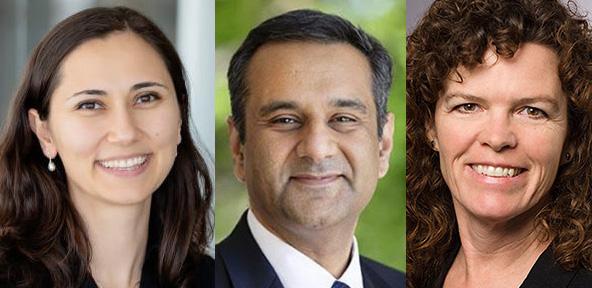A longitudinal national study led by Virginia Commonwealth University researcher Arun Sanyal, M.D., shows that people with advanced liver scarring caused by obesity, diabetes and related disorders are dying of liver disease.
Published in the New England Journal of Medicine, the research brings new urgency to tests for liver disease, particularly in populations with Type 2 diabetes, and creates a road map for future treatments of nonalcoholic fatty liver disease—treatments that could prevent the need for liver transplants for those with advanced disease.
“This is the first clear picture of the true rates of outcomes in those with [nonalcoholic fatty liver disease],” said Sanyal, a liver disease specialist at VCU Health. “And the study provides teeth to the recent American Diabetes Association guidelines to start screening for liver disease—to make the screening more mainstream.”
Many people believe that only excess alcohol consumption causes liver diseases. However, a quarter of adults worldwide have nonalcoholic fatty liver disease, a condition where excess fat is stored in the liver and is more closely linked to obesity and diabetes than alcohol consumption. Most people don’t know they have nonalcoholic fatty liver disease or are at high risk for it.
Left untreated, the disease can progress to an advanced form, where the buildup of fat in the liver can cause inflammation, scarring (known as fibrosis) and full-blown cirrhosis that leaves the liver permanently damaged. Patients typically are diagnosed when the disease is advanced and a transplant is the only option. The number of liver transplants in the U.S. has gone up every year since 2012, straining supply.
For this study, researchers followed more than 1,700 patients for a median of four years, including some for as many as 10 years, to assess their outcomes.
They found that patients with advanced fibrosis are more likely to die, especially after gastrointestinal hemorrhaging or fluid accumulation in the abdomen and progressive deterioration of brain function due to the liver disease. The results confirmed that people who have very scarred livers are the most at risk for death.
The results have implications for both the identification and treatment of nonalcoholic fatty liver disease.
“Historically, many primary care physicians and diabetes specialists have felt that, because the roots of the disease lie in insulin resistance, then if we treat the diabetes we’ve already taken care of the problem,” said Sanyal, who is also a professor in the Division of Gastroenterology, Hepatology and Nutrition in the VCU School of Medicine’s Department of Internal Medicine. “And what this shows is that, even within an especially obese, diabetic population, those who have advanced fibrosis are dying of liver disease. Just treating diabetes doesn’t get the job done.”
Drugs that stop or reverse fibrosis progression could save a significant number of lives. No medicines are approved by the Food and Drug Administration to treat nonalcoholic fatty liver disease or its more advanced version, nonalcoholic steatohepatitis.
In the U.S., it’s estimated that there are 2 million and 1.3 million individuals living with nonalcoholic steatohepatitis and fibrosis stages three and four, respectively. Based on mortality rates observed in Sanyal’s study, around 40,000 of those people die every year.
Sanyal has been studying these forms of liver disease since the mid-1990s, when he noticed more patients showing up with fatty liver disease and no history of alcohol use disorder.
“It was like a black box with no evidence-based guidance on how to look for, evaluate and manage it. There was nothing known about it,” he said. “And it struck me one day that most of the patients we were seeing had diabetes and high blood pressure, and that this could be linked to insulin resistance.”
Much of the foundational work for this study and many studies on nonalcoholic fatty liver disease and nonalcoholic steatohepatitis have their roots at VCU and in the work of its clinical researchers. Sanyal is a leader at the VCU C. Kenneth and Dianne Wright Center for Clinical and Translational Research, which has funded and supported his and others’ investigations.
“With help from colleagues in the Wright Center, I trained myself to do insulin clamps and studied insulin resistance, which was not mainstream in the liver field,” Sanyal said. “That was something that was in the realm of diabetes and endocrinology. But we did the original study showing the link between fatty liver and insulin resistance, and the field exploded.”
Nonalcoholic fatty liver disease and nonalcoholic steatohepatitis are still recently discovered diseases, Sanyal added. “There are still huge knowledge and awareness gaps—both within the physician community and the public.”
The study was funded through the National Institutes of Health’s National Institute of Diabetes and Digestive and Kidney Diseases, and several researchers involved are supported by awards from the NIH’s National Center for Advancing Translational Science.
“Dr. Sanyal and his team are remarkably productive, and this is the fourth paper on [nonalcoholic fatty liver disease] and [nonalcoholic steatohepatitis] published by Sanyal in the New England Journal of Medicine this year—and one of many in top-tier journals,” said Peter Buckley, M.D., dean of the VCU School of Medicine.
Sanyal has continued his work on liver diseases while leading multiple trials for COVID-19 treatments since March 2020.
Study finds link between blood sugar and liver disease progression
More information:
Arun J. Sanyal et al, Prospective Study of Outcomes in Adults with Nonalcoholic Fatty Liver Disease, New England Journal of Medicine (2021). DOI: 10.1056/NEJMoa2029349
Provided by
Virginia Commonwealth University
Citation:
Study reveals the true burden of the hidden pandemic of fatty liver disease (2021, October 21)
retrieved 21 October 2021
from https://medicalxpress.com/news/2021-10-reveals-true-burden-hidden-pandemic.html
This document is subject to copyright. Apart from any fair dealing for the purpose of private study or research, no
part may be reproduced without the written permission. The content is provided for information purposes only.



